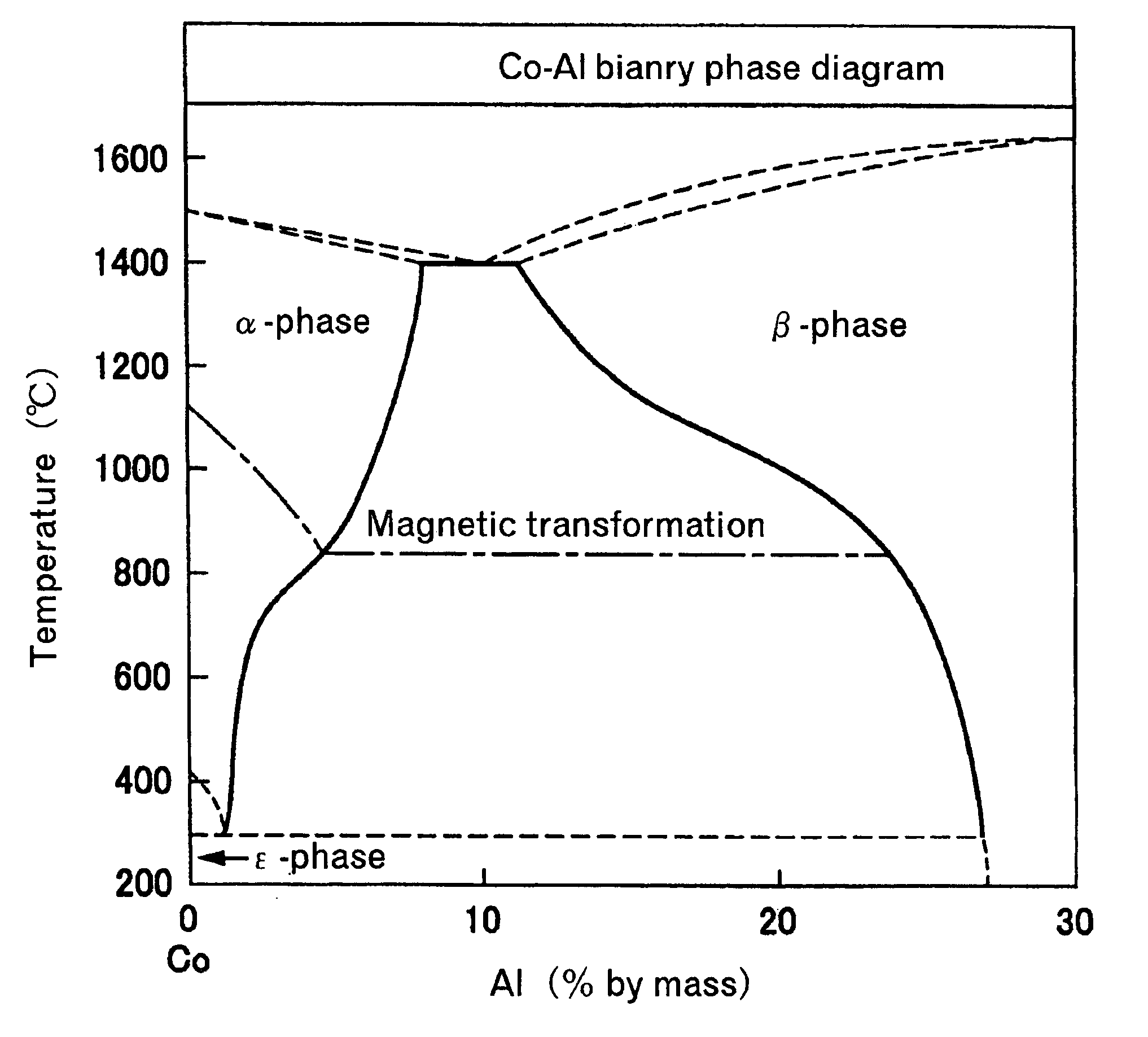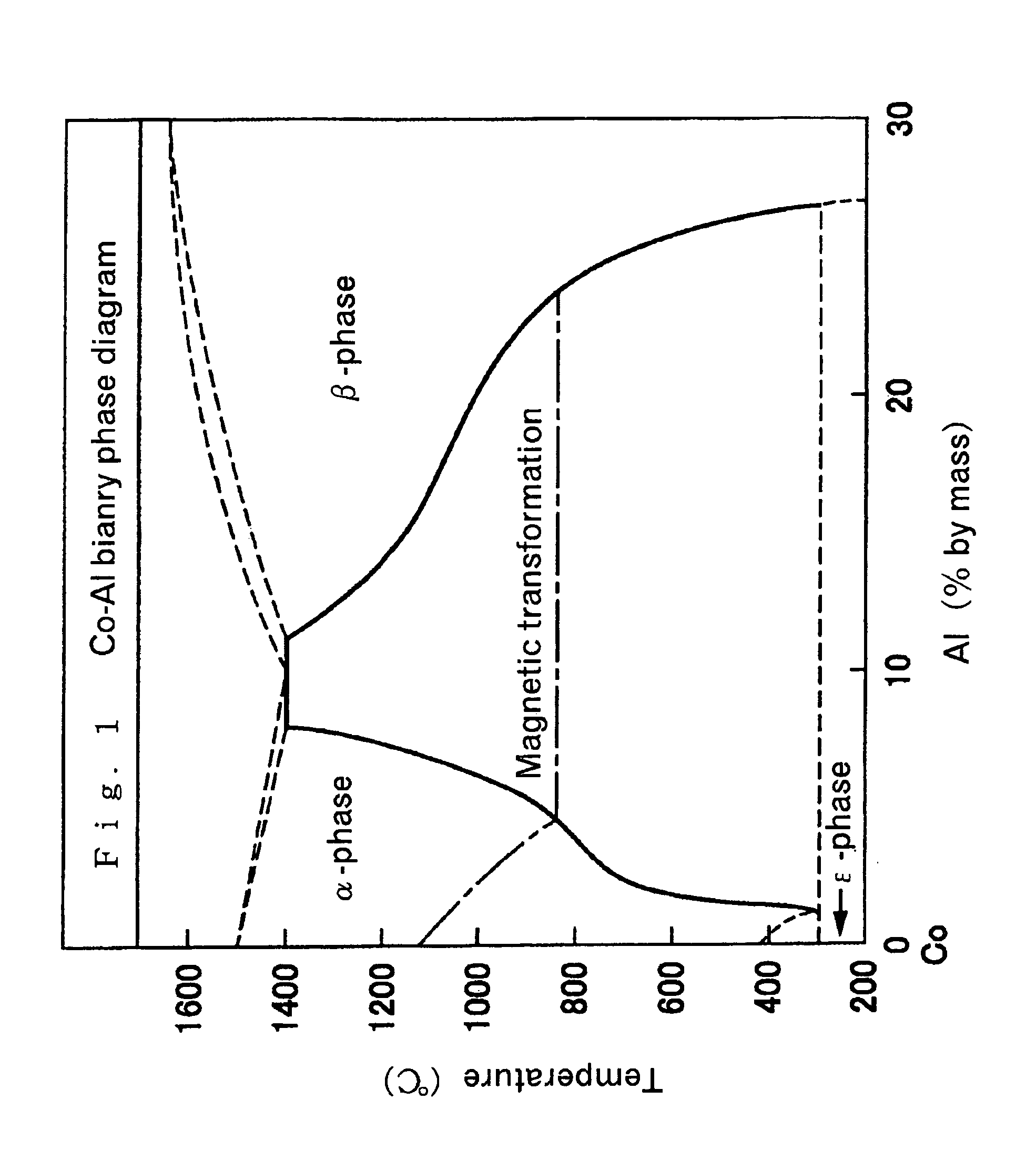HIGH-STRENGHT Co-BASED ALLOY WITH ENHANCED WORKABILITY AND PROCESS FOR PRODUCING THE SAME
a co-based alloy, high-strength technology, applied in the field of co-based alloys, can solve the problems of easy generation of cracks from precipitated phase or the boundary between the -phase and the precipitated phase, extremely low ductility of co-al binary alloys compared with usual metallic materials, and low ductility of co-al binary alloys, so as to improve workability and wear resistance.
- Summary
- Abstract
- Description
- Claims
- Application Information
AI Technical Summary
Benefits of technology
Problems solved by technology
Method used
Image
Examples
example 1
[0057]Co—Al binary alloys containing varying proportions of Al were dissolved and casted. In Test Nos. 7 to 9, each of the alloys formed cast structures during solidification and cooling process and left as they were. In Test Nos. 1 to 6 and 10, each alloy was cold-rolled to a plate thickness of 1 mm after hot rolling. Then, the cold-rolled plate was subjected to solution treatment at 1200° C. for 15 minutes, followed by aging heat-treatment at 600° C. for 12 hours and a lamellar structure was formed.
[0058]Each Co—Al alloy plate after the aging treatment was observed with a microscope and the precipitation state of the β(B2)-phase was examined. As is apparent from the research results in Table 2, in the Co—Al alloys of Test Nos. 2 to 6 where the Al content was in the range of 3 to 13%, the β(B2)-phase was precipitated in the f.c.c. structure α-phase matrix in layers. As a result, as is apparent from FIG. 2 where the Co-based alloy of Test No. 5 was observed by SEM, a clear lamellar ...
example 2
[0075]Taking the Co-based alloy of Test No. 12 in Example 1 where the finest lamellar structure was formed as an example, effects of temperature conditions in the solution treatment and aging treatment on the precipitation of layered β(B2)-phase were examined.
[0076]As is apparent from the research results in Table 4, the precipitation of the β(B2)-phase was facilitated in conditions of a solution treatment temperature in the range of 900 to 1400° C. and an aging temperature in the range of 500 to 900° C. As a result, the desired lamellar structure was obtained. The α-phase rich in ductility was stabilized by mixing with Ni and the β(B2)-phase was also softened, thereby significantly improving the ductility. The lamellar structure without micro cracks was observed after cold-rolling to a predetermined shape at a working ratio of 40%.
[0077]In the case where the aging temperature was less than 500° C., the formation and growth of the β(B2)-phase were insufficient and the lamellar struc...
example 3
[0080]Optional component is added to Co—6.9% Al—21.6% Ni alloy, effects of the optional components on the lamellar structure and the mechanical property were examined. In the corrosion test, the passive current density at 0 V vs. SCE was determined by the anode polarization test using PBS (−) solution at 25° C. The corrosion resistance was evaluated based on the following criteria:[0081]⊚ (Excellent): passive current density, 0.05 A / m2 or less;[0082]◯ (Good): passive current density, 0.05 to 0.1 A / m2;[0083]Δ (Poor): passive current density, 0.1 to 0.3 A / m2; and[0084]× (Bad): passive current density, 0.3 A / m2 or more.
[0085]Further, the workability was examined by the same standard as that of Example 1.
[0086]As is apparent from the research results in Table 6, the lamellar structure is preserved and the corrosion resistance, strength, and elongation were enhanced by the addition of the optional components. Thus, it could be formed into a target shape without working defects such as cr...
PUM
| Property | Measurement | Unit |
|---|---|---|
| temperature | aaaaa | aaaaa |
| melting point | aaaaa | aaaaa |
| temperature | aaaaa | aaaaa |
Abstract
Description
Claims
Application Information
 Login to view more
Login to view more - R&D Engineer
- R&D Manager
- IP Professional
- Industry Leading Data Capabilities
- Powerful AI technology
- Patent DNA Extraction
Browse by: Latest US Patents, China's latest patents, Technical Efficacy Thesaurus, Application Domain, Technology Topic.
© 2024 PatSnap. All rights reserved.Legal|Privacy policy|Modern Slavery Act Transparency Statement|Sitemap



